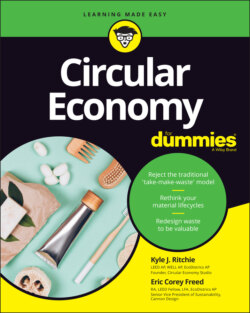Читать книгу Circular Economy For Dummies - Eric Corey Freed - Страница 97
Product stewardship
ОглавлениеPolicies alone won’t facilitate the transformation of the global economy from a linear state to a circular one. Companies and institutions will need to voluntarily restructure their designs, sourcing, manufacturing, and entire business structure to facilitate this transition. This voluntary initiative, referred to as product stewardship, can take many forms, but generally speaking, businesses that participate would adjust their products to facilitate ease of recycling, include appropriately sized packaging, and adjust the physical design of their products to allow for reuse, repair, and recycling — rather than force their products to end up in the landfill by utilizing the take-make-waste lifecycle approach. The ultimate goal of product stewardship is to adjust operations to allow for a cradle-to-cradle product lifecycle rather than a cradle-to-grave product lifecycle. (For more on the cradle-to-cradle idea, see Chapter 3.)
Imagine that an institution has accepted this product stewardship opportunity but has no idea where to begin. Fortunately, organizations are available today that can assist all types of institutions — from state and local governments to federal agencies and from retailers to manufacturers — to solve waste management issues and optimize product lifecycles. For example, the Product Stewardship Institute (www.productstewardship) — a nonprofit organization — does just that. With its office located in Boston, the institute works to encourage the adjustment of product designs by hosting stakeholder collaboration meetings. Aside from institutions that voluntarily accept the product stewardship challenge, some others may not have an option for much longer because of state-driven initiatives and laws that would require manufacturers to make significant improvements to their product lifecycles.
As population numbers continue to rise, so does the waste associated with those populations. Given this fact, it’s becoming increasingly more important for governments on all levels to provide — or support programs that provide — increased levels of material collection, reuse, and recycling. With that being said, the whole intent behind the product stewardship concept is to relieve the implementation burden from government entities and empower the companies themselves to make the change. Under this organization, the role of government then is to deliver the appropriate resources and incentives necessary to encourage the growth of companies that support product stewardship.
The point here is that a full commitment by either just business or just government won't work; it will take a collective effort and partnership between the two to make any progress. Successful implementation of product stewardship acts as a product-centered initiative with a shared responsibility distributed between the public and private sectors. The following list details the main players and stakeholders who need to be involved to help maximize the value of product stewardship:
Manufacturers: Manufacturers will be responsible for eventually eliminating the use of toxic chemicals within their processes, for increasing the durability, reuse potential, and recyclability of their products by utilizing appropriate materials, and for taking ownership of the product after the product has been discarded by the customer.
Retailers: Retailers will be responsible for selecting only product providers that can offer the customer products with innate value to both the consumer and the environment, for providing appropriate sources of media to educate customers on their options, and for providing the necessary infrastructure and incentives for customers to return products at the end of their useful life.
Consumers: The reality of the situation is that the consumer should not be expected to make the right decision out of a sense of civic duty. As unpopular as that opinion might be, for the value of the circular economy and product stewardship to be relevant, the benefits tied to making the right decision should be extreme and motivational. For example, if everyone were handed a dollar bill for every plastic bottle returned to a recycling center, do you think we’d have so many plastic bottles floating in the ocean? Of course not.
Government: The role of the government is to provide the proper playground for businesses to play. Governments will need to facilitate cooperation between community stakeholders, leverage purchasing programs to incentivize the purchase of environmentally preferable products, and produce legislation that encourages businesses to incorporate the circular economy framework into their operations.
